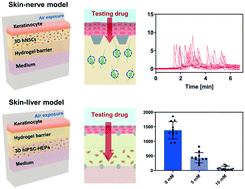Hybrid skin chips for toxicological evaluation of chemical drugs and cosmetic compounds†
Abstract
Development of drugs and cosmetics for topical application require safety tests in skin models. However, current skin models, such as skin cell sheets and artificial tissue-engineered skin, do not allow sophisticated toxicological evaluations (e.g., sensory irritation, hepatotoxicity). Animal models are prohibited worldwide for testing cosmetics. Therefore, reliable human skin models that recapitulate physiological events in skin tissue need to be established under in vitro settings. In this study, hybrid human skin models that enable delicate toxicological evaluations of drugs and cosmetic compounds are demonstrated. To recapitulate skin cornification, keratinocytes in the top layer of a vertical microfluidic chip were cultured at the air–liquid interface. For the skin–nerve hybrid model, differentiated neural stem cells in 3D collagen were positioned adjacent to and right below the skin layer. This model enables real-time quantitative skin sensitization analysis following chemical treatments by detecting alterations in neuronal activity in combination with a calcium imaging technique. For the skin–liver model, hepatic cells derived from pluripotent stem cells were cultured in 3D collagen distant from the skin layer. Potential hepatotoxicity of cutaneously applied chemicals in this model can be evaluated by quantification of glutathione and reactive oxygen species. Our study suggests that 3D hybrid skin chips would provide useful human skin models in pharmaceutical and cosmetic industries.



 Please wait while we load your content...
Please wait while we load your content...